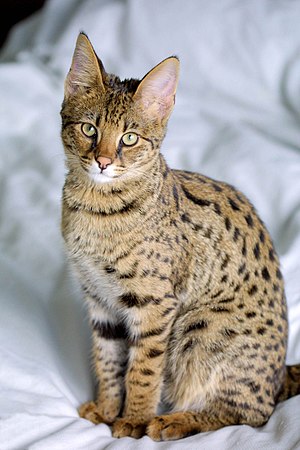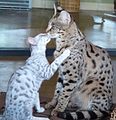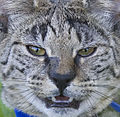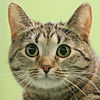Savannah cat
| Savannah cat | |
|---|---|

|
|
| Race data | |
| Shoulder height | up to 45 cm |
| length | up to 120 cm |
| Weight (F1 generation) | Male: Ø 10 kg. Cat: Ø 8 kg |
| allowed colors | Silver Spotted Tabby Brown Spotted Tabby Black / Black Smoke |
| colors not allowed | all other |
| permitted coat drawing | Spot / smoke |
| not allowed coat drawing | |
| List of cat breeds | |
The Savannah cat is a young exotic domestic cat breed that emerged from the crossing of a serval with a domestic cat , which is why the Savannah cat also has many of the characteristics of the serval. The Savannah cat is one of the hybrid breeds. It is a TICA recognized breed and is considered one of the most expensive domestic cat breeds in the world. It costs (depending on generation and percentage of wild blood) between 1,000 and 15,000 euros and can be up to 1.2 m long with a shoulder height of 45 cm.
history
1986 was unexpectedly the first F1 - hybrid cat out of the combination of a Servalkaters with a "Seal Point" -Siamkatze. Actually, Judee Frank had borrowed the serval cat from Suzi Mustascio to cover a serval cat. While the tomcat was housed with a Siamese cat, the Siamese cat was mated. According to an agreement, the only animal in the litter, a female, was loaned to Suzi Mustascio, who bred the first F2 hybrids in 1989 (a tomcat, a cat) and promoted publications. There are, however, various stories circulating about the first F1 hybrids, because cats of different breeds have since been mated with serval cats to obtain F1 hybrids. The breed was named "Savannah" after the serval's original habitat. Different breeds were used for the crossing: Bengal , Egyptian Mau , Ocicat , Oriental Shorthair , Serengetis , domestic cats and Maine Coon . Today only the breeds Egyptian Mau , Ocicat , Oriental Shorthair and Domestic Shorthair are permitted by TICA . In order to obtain young animals with the best possible type, Savannah females are mated with Savannah males. This also increases the proportion of wild blood.
Appearance
The Savannah is a tall, slender cat with long legs, a long neck, and a narrow, small head and large ears. As with the serval , the fur has a spotted pattern . In general, the color of the Savannah is a golden to beige base tone with a light underside. There are also other colors depending on the breeds crossed. Because of the sterility of the males in the first four generations, domestic cats had to be crossed. In the meantime, however, there are enough fertile Savannah males available for breeding, so that Savannah-to-Savannah matings are the standard today. The aim of breeding is to make the Savannah appear like the smaller image of a serval. Although mostly smaller than a serval, it is one of the largest domestic cat breeds in the first generation (data refer to a fully-grown male) with a weight of 9 to 12 kg and a shoulder height of 40 to 45 cm. The size decreases with the following generations, but the fur pattern, long-legged appearance and the movement pattern of the serval remain recognizable.
Generations
The Savannah cat is still differentiated between generations. The generations are designated with F for branch generation. With F1 the immediate descendants of the parents' generation (mother or father is necessarily a Serval), i.e. the daughter generation, with F2 the grandchildren etc.
In the F1 generation, the proportion of wild blood is between 50% (when a serval is mated with a house cat) and well over 80% (when a serval male is mated with an F1 female). If you cross an F1 generation Savannah with a regular house cat or an F5 Savannah, you get an F2 generation Savannah . This means that the genetic share of the wild cat is still at least 25%. And if you cross the F2 generation again with a domestic cat or an F5 Savannah, you get a Savannah of the F3 generation, etc.
The proportion of wild blood in each generation is usually at least:
F1: 50%
F2: 25%
F3: 12.5%
F4: 6.25%
F5: 3%
However, these percentages are of a theoretical nature, since in breeding it is normally not house cats but Savannahs that are paired with one another - the proportion of wild blood is therefore usually much higher. For the keeping of the F1 to F4 generations, special holding regulations apply in Germany (for example an outdoor and an indoor enclosure) and the keeping is notifiable. In Switzerland, an F3 cat can already be kept like a normal house cat.
Essence
Savannahs are considered friendly, sociable, playful animals who get along with other pets. Unlike most other domestic cat breeds, they are not afraid of water. Their reaction time and jumping power are superior to that of the normal house cat. A Savannah takes almost three years to fully mature and is able to jump two meters from a standing position.
attitude
Depending on the branch generation, different demands are made on the keeping. An F1 or F2 needs an open-air enclosure for spacious living space. For the Savannah cats of generation F1 – F4 there is a registration requirement in all federal states of Germany. The same holding requirements apply to generation F1 as to a serval. The requirements and permits can vary depending on the federal state. In order to receive a holding permit, a species-appropriate housing condition must be proven before the purchase. This means that there must be an outdoor enclosure and an indoor enclosure. In Germany it is mandatory that the outdoor enclosure has a size of at least 15 m². Wildlife is prohibited by law for Savannah cats so as not to endanger native wildlife. Furthermore, Savannahs are unsuitable for uncontrolled freewheeling because they have a strong hunting instinct.
The Savannah of the F1 generation are very original in behavior, need a lot of exercise, have a strong hunting instinct and are much larger than their relatives in the F5 generation. These hardly have any wild blood and their posture resembles that of a normal active cat. A Savannah does not count as a hybrid until the F5 generation.
The first generations in particular are quite demanding when it comes to nutrition. They should be fed primarily with raw feed and fresh prey.
gallery
Scarlett's Magic , with a shoulder height of around 45 cm, was for a time the largest domestic cat in the world (according to the Guinness Book of Records )
Web links
Individual evidence
- ↑ a b c d e f g Origin and History Savannah. In: www.dracoventures.com. Retrieved October 23, 2016 .
- ^ Blast from the Past. . . . The Very First F1 Savannah . In: Feline Conservation Federation . 51, No. 4, 2007, p. 32. (First publication: Suzy Wood (pseudonym), LIOC-Newsletter, Nov./Dec. 1986, LIOC-ESCF , 30 (6): 15.)
- ^ Blast from the Past. . . . The Very First F2 Savannahs . In: Feline Conservation Federation . 51, No. 5, 2007, pp. 38-39. (First publication: LIOC newsletter, July / August 1989, LIOC-ESCF , 33 (4): 4–5.)
- ↑ Sarah Hartwell: Domestic x Serval and Caracal Hybrids . 2008 ( ifness.com [PDF; accessed June 8, 2018] First version 1993).
- ^ History. Night Fall, 2017, accessed June 8, 2018 .
- ↑ a b c Savannah. In: geliebte-katze.de. Retrieved October 23, 2016 .
- ↑ a b (null): Keeping Savannah Shetani breeding cats. In: www.savannah-shetani.de. Retrieved October 23, 2016 .
- ↑ (null): Keeping Savannah Shetani breeding cats. In: www.savannah-shetani.de. Retrieved October 23, 2016 .
- Jump up ↑ Savannah: Race Description, History, Nature, and Husbandry. In: www.tierfreund.de. Retrieved October 23, 2016 .









